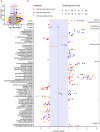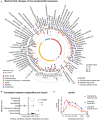Dynamic patterns of postprandial metabolic responses to three dietary challenges
- PMID: 36211489
- PMCID: PMC9540193
- DOI: 10.3389/fnut.2022.933526
Dynamic patterns of postprandial metabolic responses to three dietary challenges
Abstract
Food intake triggers extensive changes in the blood metabolome. The kinetics of these changes depend on meal composition and on intrinsic, health-related characteristics of each individual, making the assessment of changes in the postprandial metabolome an opportunity to assess someone's metabolic status. To enable the usage of dietary challenges as diagnostic tools, profound knowledge about changes that occur in the postprandial period in healthy individuals is needed. In this study, we characterize the time-resolved changes in plasma levels of 634 metabolites in response to an oral glucose tolerance test (OGTT), an oral lipid tolerance test (OLTT), and a mixed meal (SLD) in healthy young males (n = 15). Metabolite levels for samples taken at different time points (20 per individual) during the challenges were available from targeted (132 metabolites) and non-targeted (502 metabolites) metabolomics. Almost half of the profiled metabolites (n = 308) showed a significant change in at least one challenge, thereof 111 metabolites responded exclusively to one particular challenge. Examples include azelate, which is linked to ω-oxidation and increased only in OLTT, and a fibrinogen cleavage peptide that has been linked to a higher risk of cardiovascular events in diabetes patients and increased only in OGTT, making its postprandial dynamics a potential target for risk management. A pool of 89 metabolites changed their plasma levels during all three challenges and represents the core postprandial response to food intake regardless of macronutrient composition. We used fuzzy c-means clustering to group these metabolites into eight clusters based on commonalities of their dynamic response patterns, with each cluster following one of four primary response patterns: (i) "decrease-increase" (valley-like) with fatty acids and acylcarnitines indicating the suppression of lipolysis, (ii) "increase-decrease" (mountain-like) including a cluster of conjugated bile acids and the glucose/insulin cluster, (iii) "steady decrease" with metabolites reflecting a carryover from meals prior to the study, and (iv) "mixed" decreasing after the glucose challenge and increasing otherwise. Despite the small number of subjects, the diversity of the challenges and the wealth of metabolomic data make this study an important step toward the characterization of postprandial responses and the identification of markers of metabolic processes regulated by food intake.
Keywords: dietary challenge; longitudinal metabolomics; metabolic adaptation; nutritional metabolomics; postprandial metabolism; response patterns; time-series data.
Copyright © 2022 Weinisch, Fiamoncini, Schranner, Raffler, Skurk, Rist, Römisch-Margl, Prehn, Adamski, Hauner, Daniel, Suhre and Kastenmüller.
Conflict of interest statement
The authors declare that the research was conducted in the absence of any commercial or financial relationships that could be construed as a potential conflict of interest.
Figures






References
LinkOut - more resources
Full Text Sources
Medical

